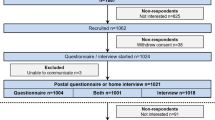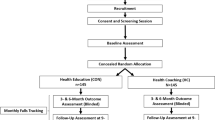Abstract
Objective
Performance measures provide important information, but the meaning of change in these measures is not well known. The purpose of this research is to 1) examine the effect of treatment assignment on the relationship between self-report and performance; 2) to estimate the magnitude of meaningful change in 400- meter walk time (400MWT), 4-meter gait speed (4MGS), and Short Physical Performance Battery (SPPB) and 3) to evaluate the effect of direction of change on estimates of magnitude.
Design
This is a secondary analysis of data from the LIFE-P study, a single blinded randomized clinical trial. Using change over one year, we applied distribution-based and anchor-based methods for self-reported mobility to estimate minimally important and substantial change in 400MWT, 4MGS and SPPB.
Setting
Four university-based clinical research sites.
Participants
Sedentary adults aged 70–89 whose SPPB scores were less than 10 and who were able to complete a 400MW at baseline (n=424).
Interventions
A structured exercise program versus health education.
Measurements
400MWT, 4MGS, SPPB.
Results
Relationships between self-report and performance measures were consistent between treatment arms. Minimally significant change estimates were 400MWT: 20–30 seconds, 4MGS: 0.03–0.05m/s and SPPB: 0.3–0.8 points. Substantial changes were 400MWT: 50–60 seconds, 4MGS: 0.08m/s, SPPB: 0.4–1.5 points. Magnitudes of change for improvement and decline were not significantly different.
Conclusions
The magnitude of clinically important change in physical performance measures is reasonably consistent using several analytic techniques and appears to be achievable in clinical trials of exercise. Due to limited power, the effect of direction of change on estimates of magnitude remains uncertain.
Similar content being viewed by others
References
Enright PL, McBurnie MA, Bittner V, Tracy RP, McNamara R, Arnold A et al. The 6-min walk test: a quick measure of functional status in elderly adults. Chest 2003;123(2):387–398.
Newman AB, Simonsick EM, Naydeck BL, Boudreau RM, Kritchevsky SB, Nevitt MC et al. Association of long-distance corridor walk performance with mortality, cardiovascular disease, mobility limitation, and disability. Jama 2006;295(17):2018–2026.
Rogers ME, Rogers NL, Takeshima N, Islam MM. Methods to assess and improve the physical parameters associated with fall risk in older adults. Prev Med 2003;36(3):255–264.
Topolski TD, LoGerfo J, Patrick DL, Williams B, Walwick J, Patrick MB. The Rapid Assessment of Physical Activity (RAPA) among older adults. Prev Chronic Dis 2006;3(4):A118.
Perera S, Mody SH, Woodman RC, Studenski SA. Meaningful change and responsiveness in common physical performance measures in older adults. J Am Geriatr Soc 2006;54(5):743–749.
Arai T, Obuchi S, Inaba Y, Nagasawa H, Shiba Y, Watanabe S et al. The effects of short-term exercise intervention on falls self-efficacy and the relationship between changes in physical function and falls self-efficacy in Japanese older people: a randomized controlled trial. Am J Phys Med Rehabil 2007;86(2):133–141.
Avraham F, Aviv S, Ya’akobi P, Faran H, Fisher Z, Goldman Y et al. The efficacy of treatment of different intervention programs for patellofemoral pain syndrome—a single blinded randomized clinical trial. Pilot study. Scientific World Journal 2007;7:1256–1262.
Bradshaw BG, Richardson GE, Kumpfer K, Carlson J, Stanchfield J, Overall J et al. Determining the efficacy of a resiliency training approach in adults with type 2 diabetes. Diabetes Educ 2007;33(4):650–659.
Sullivan KJ, Brown DA, Klassen T, Mulroy S, Ge T, Azen SP et al. Effects of Task-Specific Locomotor and Strength Training in Adults Who Were Ambulatory After Stroke: Results of the STEPS Randomized Clinical Trial. Phys Ther 2007.
Guyatt GH, Osoba D, Wu AW, Wyrwich KW, Norman GR. Methods to explain the clinical significance of health status measures. Mayo Clin Proc 2002;77(4):371–383.
Wyrwich KW, Bullinger M, Aaronson N, Hays RD, Patrick DL, Symonds T. Estimating clinically significant differences in quality of life outcomes. Qual Life Res 2005;14(2):285–295.
Guralnik JM, Simonsick EM, Ferrucci L, Glynn RJ, Berkman LF, Blazer DG et al. A short physical performance battery assessing lower extremity function: association with self-reported disability and prediction of mortality and nursing home admission. J Gerontol 1994;49(2):M85–M94.
Guralnik JM, Ferrucci L, Pieper CF, Leveille SG, Markides KS, Ostir GV et al. Lower extremity function and subsequent disability: consistency across studies, predictive models, and value of gait speed alone compared with the short physical performance battery. The journals of gerontology 2000;55(4):M221–M231.
Katula JA, Kritchevsky SB, Guralnik JM, Glynn NW, Pruitt L, Wallace K et al. Lifestyle Interventions and Independence for Elders pilot study: recruitment and baseline characteristics. J Am Geriatr Soc 2007;55(5):674–683.
Pahor M, Blair SN, Espeland M, Fielding R, Gill TM, Guralnik JM et al. Effects of a physical activity intervention on measures of physical performance: Results of the lifestyle interventions and independence for Elders Pilot (LIFE-P) study. The journals of gerontology 2006;61(11):1157–1165.
Rejeski WJ, Fielding RA, Blair SN, Guralnik JM, Gill TM, Hadley EC et al. The lifestyle interventions and independence for elders (LIFE) pilot study: design and methods. Contemp Clin Trials 2005;26(2):141–154.
Newman AB, Haggerty CL, Kritchevsky SB, Nevitt MC, Simonsick EM. Walking performance and cardiovascular response: associations with age and morbidity—the Health, Aging and Body Composition Study. The journals of gerontology 2003;58(8):715–720.
Studenski S, Perera S, Wallace D, Chandler JM, Duncan PW, Rooney E et al. Physical performance measures in the clinical setting. J Am Geriatr Soc 2003;51(3):314–322.
Cohen J. Statistical power analysis for the behavioral sciences. 2nd ed. Hillsdale, NJ: Lawrence Erlbaum; 1988.
Yost KJ, Eton DT. Combining distribution- and anchor-based approaches to determine minimally important differences: the FACIT experience. Eval Health Prof 2005;28(2):172–191.
Wyrwich KW, Nienaber NA, Tierney WM, Wolinsky FD. Linking clinical relevance and statistical significance in evaluating intra-individual changes in health-related quality of life. Medical care 1999;37(5):469–478.
Ostir GV, Volpato S, Fried LP, Chaves P, Guralnik JM. Reliability and sensitivity to change assessed for a summary measure of lower body function: results from the Women’s Health and Aging Study. Journal of clinical epidemiology 2002;55(9):916–921.
Rolland YM, Cesari M, Miller ME, Penninx BW, Atkinson HH, Pahor M. Reliability of the 400-m usual-pace walk test as an assessment of mobility limitation in older adults. J Am Geriatr Soc 2004;52(6):972–976.
Crosby RD, Kolotkin RL, Williams GR. Defining clinically meaningful change in health-related quality of life. Journal of clinical epidemiology 2003;56(5):395–407.
Wyrwich KW, Wolinsky FD. Identifying meaningful intra-individual change standards for health-related quality of life measures. J Eval Clin Pract 2000;6(1):39–49.
MacKnight C, Rockwood K. Rasch analysis of the hierarchical assessment of balance and mobility (HABAM). Journal of clinical epidemiology 2000;53(12):1242–1247.
Author information
Authors and Affiliations
Corresponding author
Rights and permissions
About this article
Cite this article
Kwon, S., Perera, S., Pahor, M. et al. What is a meaningful change in physical performance? Findings from a clinical trial in older adults (the LIFE-P study). J Nutr Health Aging 13, 538–544 (2009). https://doi.org/10.1007/s12603-009-0104-z
Received:
Accepted:
Published:
Issue Date:
DOI: https://doi.org/10.1007/s12603-009-0104-z




